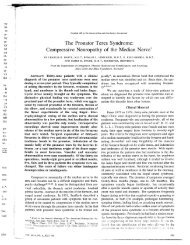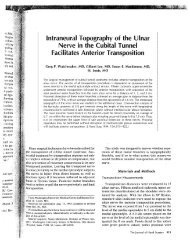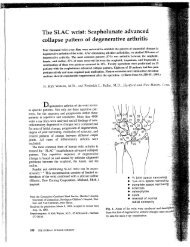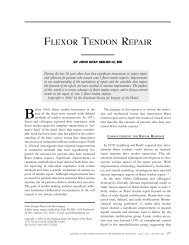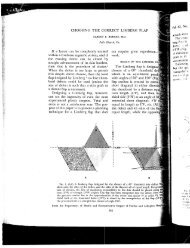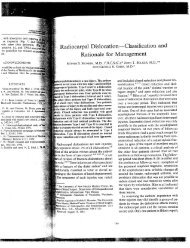Pollicization of the Index Finger
Pollicization of the Index Finger
Pollicization of the Index Finger
You also want an ePaper? Increase the reach of your titles
YUMPU automatically turns print PDFs into web optimized ePapers that Google loves.
1612 DIETER BUCK-GRAMCKO<br />
ages, except for infants under <strong>the</strong> age <strong>of</strong> fifteen months, who could not cooperate to<br />
demonstrate pinch, but even <strong>the</strong>se infants were able to use <strong>the</strong> hand operated on in a<br />
natural way and were gripping objects between <strong>the</strong> new thumb and fingers or between<br />
<strong>the</strong> new thumb and <strong>the</strong> long finger. Active flexion <strong>of</strong> <strong>the</strong> pollicized finger sometimes<br />
began in <strong>the</strong> fourth week, but in <strong>the</strong> majority not before <strong>the</strong> third month. The<br />
motion increased slowly but steadily during <strong>the</strong> first year because <strong>of</strong> slow adaptive<br />
shortening <strong>of</strong> <strong>the</strong> flexor tendons, not shortened surgically.<br />
The motion and strength <strong>of</strong> radial abduction was <strong>the</strong> greatest variable in <strong>the</strong><br />
group <strong>of</strong> patients. They depended not only on <strong>the</strong> strength <strong>of</strong> <strong>the</strong> extensor muscle,<br />
and on <strong>the</strong> position <strong>of</strong> fixation <strong>of</strong> <strong>the</strong> metacarpal head relative to <strong>the</strong> remains <strong>of</strong> its<br />
base on <strong>the</strong> carpal bones, but also on <strong>the</strong> active use, and on <strong>the</strong> presence <strong>of</strong> o<strong>the</strong>r<br />
anomalies in <strong>the</strong> extremity. For instance, in <strong>the</strong> radial club hand, <strong>the</strong>re usually was<br />
little active motion in <strong>the</strong> interphalangeal joints <strong>of</strong> <strong>the</strong> index and long fingers, and.<br />
<strong>the</strong>refore, after pollicization, little motion existed in <strong>the</strong> former metacarpophalangeal<br />
joint and none in <strong>the</strong> interphalangeal joints. In this case, <strong>the</strong>refore, <strong>the</strong> digit had to<br />
be fixed in less radial abduction and act more as a post for <strong>the</strong> function <strong>of</strong> pinch.<br />
All <strong>of</strong> <strong>the</strong> children used <strong>the</strong>ir new thumbs naturally except those with radial<br />
club hand, who frequently used <strong>the</strong> side-to-side grip <strong>of</strong> ring and long fingers for<br />
smaller objects. One o<strong>the</strong>r exception was a child with a "five fingered" hand, who<br />
used this method for pinch preoperatively and continued to do so because <strong>of</strong> insufficient<br />
power in <strong>the</strong> intrinsic muscles. None <strong>of</strong> <strong>the</strong> new thumbs showed sensory or<br />
vascular deficiency with one exception a hand in which <strong>the</strong>re was anomalous absence<br />
<strong>of</strong> <strong>the</strong> pahnar arteries and postoperative thrombosis <strong>of</strong> <strong>the</strong> metacarpal artery<br />
with necrosis and subsequent loss <strong>of</strong> <strong>the</strong> thumb.<br />
It was necessary to add skin grafts in six operations, in three <strong>of</strong> which scars<br />
from previous operations were <strong>the</strong> reason. In <strong>the</strong> o<strong>the</strong>r three a small lull thickness<br />
graft was used from <strong>the</strong> excess skin on <strong>the</strong> dorsum <strong>of</strong> <strong>the</strong> finger. In <strong>the</strong>se <strong>the</strong> reason<br />
was retention <strong>of</strong> much <strong>of</strong> <strong>the</strong> second metacarpal because <strong>of</strong> <strong>the</strong> shortness <strong>of</strong> <strong>the</strong><br />
phalanges.<br />
The reattached intrinsic muscles were important for <strong>the</strong> appearance as well as<br />
for <strong>the</strong> function <strong>of</strong> <strong>the</strong> thumb. They gave to <strong>the</strong> transposed index finger <strong>the</strong> appearance<br />
<strong>of</strong> a thumb. They also produced a real <strong>the</strong>nar eminence, and, after a period<br />
<strong>of</strong> training, led to relatively normal mobility <strong>of</strong> <strong>the</strong> thumb (Fig. 9).<br />
Fro. 9<br />
Normal opposition and radial abduction <strong>of</strong> a pollicised index finger with a real <strong>the</strong>nar eminence<br />
by <strong>the</strong> described muscle transfer.<br />
THE JOURNAL OF BONE AND JOINT SURGERY<br />
Hyg<br />
years<br />
on th<br />
were<br />
were<br />
rotat~<br />
biliz~:<br />
perf~<br />
radi:<br />
<strong>the</strong> ,<br />
ring<br />
pop<br />
vOI



